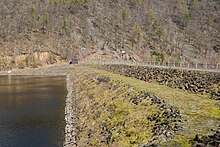| Bílina | |
|---|---|
 The Bílina in Hostomice The Bílina in Hostomice | |
| Location | |
| Country | Czech Republic |
| Region | Ústí nad Labem |
| Physical characteristics | |
| Source | |
| • location | Blatno, Ore Mountains |
| • elevation | 823 m (2,700 ft) |
| Mouth | |
| • location | Elbe |
| • coordinates | 50°39′28″N 14°2′37″E / 50.65778°N 14.04361°E / 50.65778; 14.04361 |
| • elevation | 133 m (436 ft) |
| Length | 82.0 km (51.0 mi) |
| Basin size | 1,082.5 km (418.0 sq mi) |
| Discharge | |
| • average | 5.9 m/s (210 cu ft/s) near estuary |
| Basin features | |
| Progression | Elbe→ North Sea |
The Bílina (Czech pronunciation: [ˈbiːlɪna]; German: Biela) is a river in the Czech Republic, a left tributary of the Elbe River. It flows through the Ústí nad Labem Region. It is 82.0 km (51.0 mi) long. The river flows through a densely populated area with a high concentration of industry. It is infamously known as the dirtiest Czech river, even though water quality has improved significantly in the 21st century.
Etymology
The name of the river is derived from the Czech word bílá (i.e. 'white'). Names of rivers with this colour in the name often referred to the stony or pebbly nature of the river bed.
Characteristic

The Bílina originates in the territory of Blatno in the Ore Mountains at an elevation of 823 m (2,700 ft) and flows to Ústí nad Labem, where it enters the Elbe River at an elevation of 133 m (436 ft). It is 82.0 km (51.0 mi) long. Its drainage basin has an area of 1,082.5 km (418.0 sq mi).
The longest tributaries of the Bílina are:
| Tributary | Length (km) | River km | Side |
|---|---|---|---|
| Srpina | 28.2 | 45.7 | left |
| Bystřice | 19.9 | 20.1 | left |
| Bouřlivec | 18.6 | 30.6 | left |
| Bílý potok | 15.8 | 55.2 | left |
| Ždírnický potok | 14.5 | 2.8 | left |
| Loupnice | 13.1 | 55.9 | left |
Settlements

The river flows through the densely populated area of the Most Basin. The most notable settlements on the river are the cities of Ústí nad Labem and Most. The river flows through the municipal territories of Blatno, Boleboř, Jirkov, Vrskmaň, Horní Jiřetín, Litvínov, Most, Obrnice, Želenice, Bílina, Světec, Hostomice, Ohníč, Bžany, Bystřany, Rtyně nad Bílinou, Řehlovice, Trmice and Ústí nad Labem.
Bodies of water

Two reservoirs are built on the upper course of the Bílina. There are 180 bodies of water larger than 1 ha in the basin area. The largest of them is Lake Milada with an area of 252 ha (620 acres).
Environmental issues
The big problem of the river is water pollution. In 2006, it was declared the dirtiest river in the Czech Republic. The river passes through the most industrial area of the country and, in addition to wastewater from industry, it also receives wastewater from surface mining of lignite and from households. Mercury, arsenic, organic substances and other pollutants appeared here. The main problem was the pollution that had accumulated from past decades. Paradoxically, in the upper course of the river, before it reaches the populated area, the water quality is at such a high level that it is suitable even for infants.
Although it has been considered the dirtiest Czech river for decades, the state of pollution improved significantly in the 2010s. The main source of pollution is the chemical factory Orlen Unipetrol in Litvínov. The occurrence of Enterococcus bacteria, indicating the discharge of faeces into the river, is also a problem. Mercury remains present in the sediments.
Coal mining has changed the course of the river, which was partially channeled by a long pipeline in the 1980s. In 2016, a section of the pipeline was replaced by a new riverbed. The rest of the pipeline, which is the Ervěnice Corridor with a length of 4.7 km (2.9 mi), is planned to be replaced in 2025–2027. The plan is to construct meanders and pools, extend the flow path and reduce the slope of the bottom.
Fauna
The improvement of water purity led to the return of fish, and already in 2006 most of the species typical of Czech rivers were found in it, e.g. Eurasian carp, perch and common bream. New fish are introduced into the river twice a year.
Tourism
The Bílina is suitable for river tourism. About 50 km (31 mi) of the river is navigable. There are only few weirs on the river and the lower course is suitable even for less experienced paddlers.
See also
References
- Šmilauer, Vladimír. "O původu názvů českých řek". Naše řeč (in Czech). Institute of the Czech Language. Retrieved 2024-08-15.
- ^ "Základní charakteristiky toku Bílina a jeho povodí" (in Czech). T. G. Masaryk Water Research Institute. Retrieved 2024-08-15.
- "Vodní toky". Evidence hlásných profilů (in Czech). Czech Hydrometeorological Institute. Retrieved 2024-10-18.
- ^ Baroch, Pavel (2006-07-23). "Nejšpinavější řekou v Česku je Bílina" (in Czech). Aktuálně.cz. Retrieved 2024-08-15.
- Minaříková, Kamila (2018-10-02). "Řeka Bílina je čistější než kdysi, hodnoty ale kazí průmysl i fekálie". Deník.cz (in Czech). Retrieved 2024-08-15.
- ^ "V řece Bílině je větší množství rtuti, průmyslové znečištění ohrožuje vodní živočichy". Seznam Zprávy (in Czech). 2021-11-15. Retrieved 2024-08-15.
- "Těžba uhlí Bílinu zahnala do trubek. Teď má nové koryto". iDNES.cz (in Czech). 2016-10-28. Retrieved 2024-08-15.
- Otcovský, Karel (2024-09-04). "Řeka Bílina se vrátí z trubek Ervěnického koridoru z 80. let zpět do přírodního koryta". iDNES.cz (in Czech). Retrieved 2024-09-06.
- "Bílina – severočeská "průmyslová" řeka" (in Czech). Pádler. Retrieved 2024-08-16.
External links
- River flow at Trmice station – Flood Warning and Forecasting Service of the Czech Hydrometeorological Institute